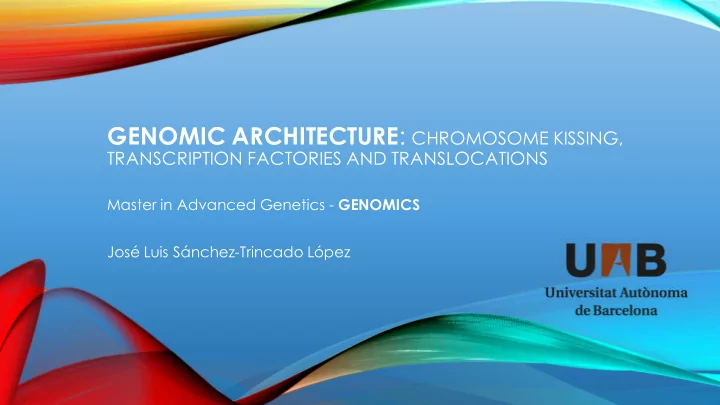

GENOMIC ARCHITECTURE : CHROMOSOME KISSING, TRANSCRIPTION FACTORIES AND TRANSLOCATIONS Master in Advanced Genetics - GENOMICS José Luis Sánchez-Trincado López
INTRODUCTION The cell nucleus is not randomly organized Individual chromosomes occupy distinct positions within the nucleus: chromosome territories Transcription regulation depends upon genomic regions repositioning Lanctôt, C. (2007) Bender, M.A. (2012)
Spatial co-localization, the so-called gene kissing TRANSCRIPTION REPRESSION ACTIVATION - PolycombGroup ( PcG ) proteins - Foci enriched in RNA - Both cis and trans regulation pol II ( Transcription - Fab7 regulatory sequences factories ) Lanctôt, C. (2007).
So… How does the chromatin manage to get either mobilized or stabilized? - Actin and myosin Movement - RNA-polymerase holoenzymes - RNAi machinery? Fixation There are two non-exclusive models to explain chromatin rearrangements: - Pre-existing compartments - Self-organization Lanctôt, C. (2007)
Spatial organization mapping Wong, B. (2011) de Wit, E. (2012) Cai, S. (2006)
TRANSCRIPTION FACTORIES Transcription factories describe the discrete sites where transcription occurs (in the nucleus). It contains at least two active polymerases and two DNA templates - Polymerase concentration: about 1000 fold higher - Even 30 polymerase working at a time together - From 50 to 500nm in width - Tethered to nuclear matrix Chakalova, L. (2005)
TRANSCRIPTION FACTORIES Position effects and specialization - Factories become specialized with the action of transcription factors (left) - Genomic position affects transcription (right) Feuerborn, A. (2015) Feuerborn, A. (2015)
TRANSCRIPTION FACTORIES A source of translocations Gene clustering à Consequences on genome stability Incorrect rearrangement à translocation Genomic juxtaposition : before or after DNA damage? Rearrangements sequencing identifies the “ TRANSLOCATOME ” Osborne, C.S. (2013)
TRANSCRIPTION FACTORIES Translocation-derived cancers Shared position within the nucleus for rearranged genes in translocation-derived cancers . Burkitt’s lymphoma is an illustrative case Burkitt’s lymphoma Programmed DNA break and repair is an integral part of the transcription process à topoisomerase Topoisomerase 2B inhibitors ( etoposide ) spark off therapy-related second cancers Etoposide
CONCLUSIONS: a summary • Nuclear periphery and heterochromatin vicinity areas share a decreased mobility and are genomic silencing regions, while the centre is dynamic and transcriptionally active . • Gene kissing is the intra (cis) or interchromosomal (trans) overlap of sequences within the same position, causing transcription activation or repression. • Transcription factories constitute a source of genomic rearrangements and translocations . Many of them are responsible for the arise of cancer . • New genome-wide technologies are being applied to tease apart how DNA sequences interact, thereby helping to build up the human “ translocatome ”.
DISCUSSION AND FURTHER INSIGHTS • As a main challenge, unveil how 1D sequence information specifies 3D architecture and organization. • Distinguish between sequence-dependent and epigenetics determinants of chromatin organization and dynamics. • Develop unbiased method s for genome wide identification of chromosome contact. • Promote the conception of focused anticancer drugs that can minimize deleterious effects in cancer genes .
References • Lanctôt, C., Cheutin, T., Cremer, M., Cavalli, G. and Cremer, T. (2007). Dynamic genome architecture in the nuclear space: regulation of gene expression in three dimensions. Nature Reviews Genetics; 8:104-115. • Cavalli, G. (2007). Chromosome kissing. Current Opinion in Genetics & Development; 17:443-450. • Feuerborn, A. and Cook, P.R. (2015). Why the activity of a gene depends on its neighbors. Trends in Genetics; 31(9):483-490. • Osborne, C.S. (2014). Molecular pathways: transcription factories and chromosomal translocations. Clinical Cancer Research; 20(2):296-300. • Ezoe, S. (2012). Secondary leukemia associated with the anti-cancer agent, etoposide, a topoisomerase II inhibitor. International Journal of Environmental Research and Public Health; 9:2444-2453.
Thank you for your attention! Any questions??
Recommend
More recommend